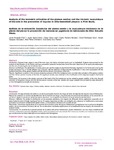Análisis de la activación isométrica del glúteo medio y la musculatura intrínseca de la planta del pie en la prevención de lesiones en jugadores de baloncesto de élite: estudio piloto

View/
Use this link to cite
http://hdl.handle.net/2183/21986Collections
Metadata
Show full item recordTitle
Análisis de la activación isométrica del glúteo medio y la musculatura intrínseca de la planta del pie en la prevención de lesiones en jugadores de baloncesto de élite: estudio pilotoAlternative Title(s)
Analysis of the isometric activation of the gluteus medius and the intrinsic musculature of the sole in the prevention of injuries in elite basketball players: a pilot studyAuthor(s)
Date
2018Citation
European Journal of Podiatry, 2018, 4 (2): 35-44 ISSN: 2445-1835
Abstract
[Resumen] Introducción: El valgo dinámico de rodilla es uno de los principales factores de riesgo de lesión de deportes de impacto como el Baloncesto. Mejorar los sistemas de análisis de identificación de los factores de riesgo y los protocolos de prevención de lesiones se ha convertido en uno de los objetivos principales del fisioterapeuta deportivo, con el objetivo de disminuir el riesgo de lesión del deportista.
Material y Métodos: Se analizó la distribución de las presiones plantares y los ángulos de alineación de los segmentos corporales en el plano frontal durante el Single-Leg-Squat Test en 10 sujetos deportistas de élite, con el objetivo de y observar la modificación a corto plazo asociada a la activación isométrica del glúteo medio y la musculatura intrínseca de la planta del pie.
Resultados: Variaciones significativas en el aumento de la presión plantar del primer metatarsiano se registraron tras la activación del glúteo medio y de la musculatura intrínseca del pie. No se obtuvieron resultados significativos en la modificación de los ángulos de alineación en el plano frontal.
Conclusiones: Un aumento de la presión plantar de la cabeza del primer metatarsiano puede relacionarse con una mayor estabilidad del miembro, mediante la activación del glúteo medio y de la musculatura intrínseca del pie. Son necesarios estudios con muestras más amplias que correlacionen los datos obtenidos en una muestra más homogénea. [Abstract] Introduction: Dynamic knee valgus is one of the main injury risk factors of impact sports such as basketball. Systems improvement for the analysis of identification of risk factors and injury prevention protocols has become one of the main objectives of the sports physiotherapist, with the aim of reducing the risk of athletes injury.
Material and Methods: The distribution of plantar pressures and the angles of alignment of the body segments in the frontal plane during the Single-Leg-Squat Test in 10 elite athletes was analyzed, with the objective of observing the modification in short-term associated with the isometric activation of the gluteus medius and the intrinsic plantar musculature of the foot.
Results: Significant variations in the increase of plantar pressure of the first metatarsal were recorded after activation of the gluteus medius and the intrinsic plantar muscles of the foot. No significant results were obtained in the modification of the alignment angle in the frontal plane.
Conclusions: An increase in the plantar pressure of the head of the first metatarsal can be related to greater stability of the limb, through activation of the gluteus medius and the intrinsic plantar muscles of the foot. Studies with larger samples that correlate the data obtained in a more homogeneous sample are necessary.
Keywords
Valgo dinámico de rodilla
Glúteo medio
Musculatura intrínseca del pie
Prevención & control
Transversal
Dynamic knee valgus
Gluteus medius
Intrinsic muscles of the foot
Prevention & control
Cross-Sectional
Glúteo medio
Musculatura intrínseca del pie
Prevención & control
Transversal
Dynamic knee valgus
Gluteus medius
Intrinsic muscles of the foot
Prevention & control
Cross-Sectional
Editor version
ISSN
2445-1835





